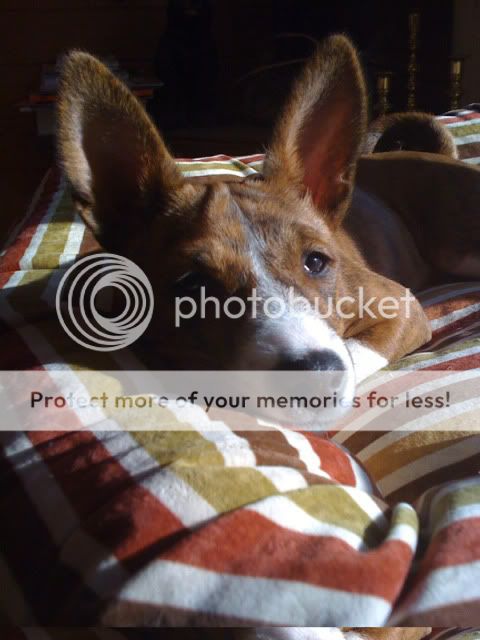@Saving Thanks so much for the information! I am researching further and continuing with her rehab exercises as best I can.
Glad you recovered from your spinal injuries.
Brindle Colouring
-
Why are some brindles darker than others? If you use a darker brindle with a R/W what would the pups be like? (I realise there could be R/W pups too) Likewise, if you use a lighter brindle? I like the darker brindles and just wondered if there was a sure way of breeding them.

-
If you breed a brindle and a tri do you get a tri colour brindle?

Cant help at all, but just had that thought when i read your questions!
-
If you breed a brindle and a tri do you get a tri colour brindle?

Cant help at all, but just had that thought when i read your questions!
As a matter of fact, you do… you get a Trindle (as they are referred to in the US)
And regarding brindle colors, no difference then all the different shades of reds that we have... some light red, some dark red, some chestnut red....
-
As a matter of fact, you do… you get a Trindle (as they are referred to in the US)
And regarding brindle colors, no difference then all the different shades of reds that we have... some light red, some dark red, some chestnut red....
Fascinating! I shall have to google some "trindle" basenjis!
Is that a recognised colour in the US? I know with pugs there are a lot of colours that are not recognised in the AKC standard but some breeders do claim to have - such as blue and brindle.
-
Why are some brindles darker than others? If you use a darker brindle with a R/W what would the pups be like? (I realise there could be R/W pups too) Likewise, if you use a lighter brindle? I like the darker brindles and just wondered if there was a sure way of breeding them.

Honestly, I don't think there is a sure way. My pup Liyah's mother is dark brindle and she was bred with a black & white male. Liyah was the only brindle pup (that looks brindle - her brothers and sisters are b&w, but brindle that can't be seen) in the litter and she is chestnut red with black striping - but not heavily brindle. She is my favourite brindle colouring (because her red is so deep) as I'm not a big fan of the dark brindles.
BTW, as a back story…I wrote in my original thread that her registered name is "The Chosen One". One of the reasons we named her that was because her breeder was going to keep her, but because her red was the chestnut red of her grandmother (my girl Ruby), I begged the breeder for her. So to me she was the perfect colour combo - Ruby red
 with just enough brindle striping.
with just enough brindle striping.The photos I've posted of her don't do her justice, because her coat colour is really beautiful in person. I have a baby pic of her that is the only one I have that shows her true colour.
-
Where can I find her pictures?
-
Here's the baby picture that is closest to what she really looks like colour wise - and even this is a little light for what her red really is:

-
AAWW. What a cutie. Her red really is red!
 Thank you.
Thank you. -
Thanks…here's another baby pic - this one is a little brown - but shows how evenly dark red she is...

-
She's a very pretty girl. Looks like she's had to grow into her ears!

I love Brindles and could look at pics of them all day long.
-
Some lines are pretty consistent in the brindle patterning they produce others are less so. It can be very difficult to predict but study the pedigree and see if there is consistency but be prepared for variation.
renaultf1 - How do you know that the black and whites carry brindle? I bred my black girl to a trindle sire and have 2 black and whites in the litter. Though I won't know for sure until I breed Sophie, I am pretty sure she does not carry brindle. I can see stripes in strong sunlight on her brother Ringo so I am pretty sure is does carry brindle.
-
Fascinating! I shall have to google some "trindle" basenjis!
Is that a recognised colour in the US? I know with pugs there are a lot of colours that are not recognised in the AKC standard but some breeders do claim to have - such as blue and brindle.
It is called a "brindle pointed Tri"… personally I am not fond of the color, but I have seen some very nice Basenjis that are Trindles. There is NO color restrictions in the breed standard in the US
-
I love that reddish brindle of yours. My first was just a plain brown brindle.